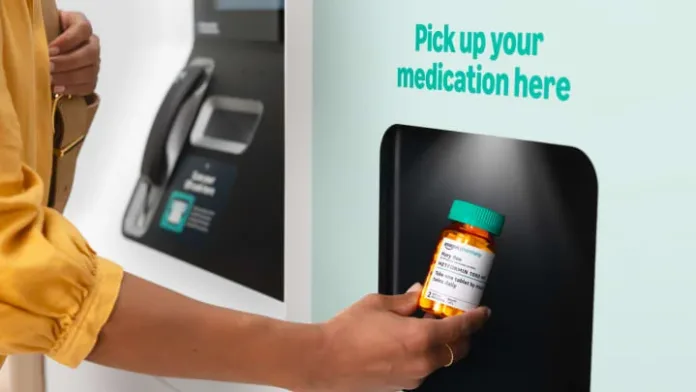Table of Contents
Amazon Pharmacy Vending Machines: A Game-Changing Move in Modern Healthcare
Amazon Pharmacy is expanding its healthcare presence by introducing prescription vending machines at One Medical clinics. This innovation, set to begin in Los Angeles in December, represents a major step in redefining how patients receive medications after doctor appointments. Squaredtech examines this launch and its potential to reshape pharmacy operations in the United States.
The Amazon Pharmacy vending machines will allow patients to collect prescribed medications immediately after their medical visits, eliminating the need to visit an external pharmacy. Operated through the existing Amazon app, these machines promise convenience, speed, and digital integration, key elements in Amazon’s approach to simplifying healthcare delivery.
Patients will now be able to check out prescriptions directly from their phones using the Amazon app. Once payment is processed, medications are ready for pickup within minutes. This immediate availability reflects Amazon’s mission to remove friction from everyday healthcare experiences.
According to Amazon Pharmacy, the kiosks will stock a wide range of commonly prescribed medications, including antibiotics, inhalers, and drugs for managing chronic conditions like hypertension. However, they will exclude controlled substances and medications requiring refrigeration. Each kiosk’s inventory will be customized based on prescribing trends at its respective One Medical location. This localized inventory model ensures that the most relevant medications are always available to patients.
Squaredtech notes that this move demonstrates Amazon’s growing interest in integrating digital systems with physical healthcare environments. The company is leveraging its deep experience in logistics and consumer technology to improve medical accessibility.
The Technology Behind Amazon Pharmacy’s Prescription Kiosks
The Amazon Pharmacy vending machines represent more than a new distribution channel. They illustrate how technology can streamline healthcare logistics. Through the Amazon app, patients can see upfront pricing details, including insurance copays and any applicable discounts. This transparency is designed to make the cost of medication clearer and prevent unexpected charges.
Patients will also have the option to connect with a licensed pharmacist via video or phone consultation before completing their purchase. This ensures that professional guidance remains part of the process, maintaining safety and compliance standards. For many, this digital-first model reduces waiting times while keeping expert advice accessible.
Squaredtech highlights that this technological model could set a precedent for future pharmacy services. Automation in healthcare is not new, but Amazon’s integration of logistics, AI-powered recommendations, and mobile payment ecosystems could make it the first major platform to combine convenience, accuracy, and speed at this scale.
Hannah McClellan, Vice President of Operations at Amazon Pharmacy, noted that many prescriptions go unfilled because patients must travel to another location after seeing their doctor. With in-office vending access, this problem could decrease dramatically. By placing Amazon Pharmacy vending machines directly in medical offices, the company is addressing one of the most persistent gaps in healthcare — the delay between prescription and pickup.
Squaredtech’s analysis suggests that this is not simply a technological upgrade but a structural change in the medication supply chain. Integrating point-of-care dispensing directly within clinical environments could redefine expectations for patient service in primary care.
Industry Impact and the Decline of Traditional Pharmacies
The Amazon Pharmacy vending machine rollout comes at a time when traditional U.S. pharmacy chains are struggling to maintain profitability. Rite Aid recently shut down its remaining stores, CVS has closed over 1,000 locations since 2021, and Walgreens reduced its footprint by more than 500 stores in the last year. These closures indicate a declining reliance on brick-and-mortar pharmacies as digital and automated alternatives grow.
Amazon’s entrance into physical dispensing via kiosks could accelerate this trend. By offering prescription access where patients already receive care, Amazon is merging convenience with necessity. This strategy not only serves patients but also strengthens Amazon’s position as a dominant player in both retail and healthcare.
Squaredtech believes this approach aligns with Amazon’s broader healthcare strategy, which includes acquisitions like One Medical and the expansion of Amazon Clinic. Together, these initiatives create an interconnected healthcare ecosystem powered by data, AI, and customer experience optimization.
The Amazon Pharmacy vending machines could also challenge traditional insurance and pharmacy benefit manager (PBM) models. By showing clear pricing and providing instant purchase options, Amazon reduces patient dependence on opaque billing systems. This could push the industry toward more transparent and competitive pricing structures.
While some healthcare experts express concern about automation replacing human pharmacists, the inclusion of digital consultation features suggests Amazon is aiming to complement, not replace, professional guidance. The convenience factor, combined with secure access and verified medical oversight, gives these kiosks an advantage in patient trust and usability.
Squaredtech’s Perspective: What This Means for the Future of Healthcare Access
At Squaredtech, we view Amazon Pharmacy’s vending machine strategy as a pivotal experiment in healthcare modernization. The combination of in-office convenience, digital payment integration, and AI-driven stock management creates a seamless ecosystem that could redefine how prescriptions are distributed globally.
This system aligns with the increasing consumer demand for immediate service. Patients expect healthcare to function like other digital experiences — fast, transparent, and accessible on mobile platforms. By meeting those expectations, Amazon is positioning itself at the intersection of healthcare, retail, and technology.
From a business standpoint, Squaredtech identifies three major implications of this development:
- Increased Efficiency in Healthcare Delivery:
The vending model reduces human errors, waiting times, and supply shortages. Automated stock tracking ensures that inventory remains aligned with local prescribing patterns. - Pressure on Traditional Pharmacies:
As Amazon continues to innovate, smaller pharmacies may struggle to match the speed and digital integration offered by these kiosks. This could lead to consolidation within the pharmacy industry or the rise of new technology-driven partnerships. - Data-Driven Healthcare Optimization:
Every transaction at an Amazon Pharmacy kiosk generates valuable data. Insights from prescription patterns can help doctors, clinics, and healthcare providers make informed decisions about medication management and patient care efficiency.
Squaredtech emphasizes that while automation and AI improve operational efficiency, regulatory oversight will remain essential. Ensuring patient safety, maintaining data privacy, and preventing misuse of automated systems will be critical as Amazon expands its presence.
Looking ahead, Amazon plans to introduce these vending machines beyond Los Angeles, potentially scaling nationwide within the next few years. If successful, this could become a standard feature in medical offices across major cities.
Final Analysis: Amazon’s Long-Term Strategy in Healthcare
The launch of Amazon Pharmacy vending machines signals more than convenience. It reflects Amazon’s long-term ambition to become a central player in digital health. The company’s control over logistics, payments, and technology gives it an unmatched advantage in simplifying how patients access essential medications.
Squaredtech believes this move demonstrates how technology companies can transform traditional healthcare models through efficiency, automation, and user-centric design. The immediate pickup feature resolves a long-standing issue in patient care: prescription abandonment. By reducing that friction, Amazon may significantly improve adherence rates and overall health outcomes.
In conclusion, Amazon Pharmacy’s vending machines for prescription drugs showcase how innovation can merge technology and healthcare in practical ways. This initiative not only enhances patient experience but also sets a new benchmark for accessibility and efficiency in pharmacy services. As more clinics adopt this model, Squaredtech expects broader industry disruption — one that could redefine what patients expect from a pharmacy in the digital era.
Stay Updated: Tech News – Emerging Technologies


